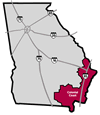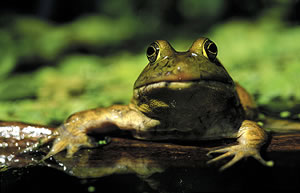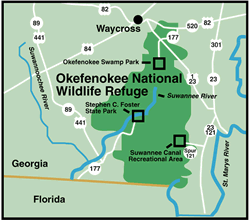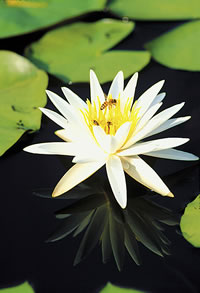
Wildlife Viewing Guide


|
Wildlife Viewing Guide |
 |
 Okefenokee
National Wildlife Refuge
Okefenokee
National Wildlife Refuge
 Description:
Encompassing an area of approximately 650 square miles, the Okefenokee offers
353,000 acres of designated national wilderness. Habitats on the refuge include
open water, wet prairie, shrub-scrub, cypress forest, and upland pine forest
on interior islands and perimeter upland areas. The refuge is the headwaters
for the St. Mary's River which flows to the Atlantic Ocean, and the famed Suwannee
River which drains to the Gulf of Mexico. The name Okefenokee is a native American
term that means "land of the trembling earth". Many floating "peat
beds" colonize with grasses, shrubs, and trees that move or shake under
the weight of a walking person. There are three points of public access to the
refuge. Stephen C. Foster State Park, Suwannee Canal Recreation Area, and the
privately operated Okefenokee Swamp Park provide good access from all vantage
points for casual visitors. Overnight stay or interior travel requires permits
and reservations.
Description:
Encompassing an area of approximately 650 square miles, the Okefenokee offers
353,000 acres of designated national wilderness. Habitats on the refuge include
open water, wet prairie, shrub-scrub, cypress forest, and upland pine forest
on interior islands and perimeter upland areas. The refuge is the headwaters
for the St. Mary's River which flows to the Atlantic Ocean, and the famed Suwannee
River which drains to the Gulf of Mexico. The name Okefenokee is a native American
term that means "land of the trembling earth". Many floating "peat
beds" colonize with grasses, shrubs, and trees that move or shake under
the weight of a walking person. There are three points of public access to the
refuge. Stephen C. Foster State Park, Suwannee Canal Recreation Area, and the
privately operated Okefenokee Swamp Park provide good access from all vantage
points for casual visitors. Overnight stay or interior travel requires permits
and reservations.
 Viewing
Information: Okefenokee NWR is surely one of the top wildlife viewing areas
in Georgia. The potential to observe different species of wildlife is probably
greater here than at any other location in the southeastern U.S. A patient and
observant watcher can encounter more than 200 species of birds, 50 mammals,
and 100 reptiles and amphibians. In the winter, waterfowl abounds, including
mallards, ring-necked ducks, wood ducks, black ducks, coots, green-winged teal,
and hooded mergansers, which are seen in the prairies along with large numbers
of greater sandhill cranes. Ospreys begin nesting. Watch for aerial courtship
displays of red-tailed hawks. Brown-headed nuthatches become active at the end
of Feb. In spring, purple martins, parula warblers, and eastern kingbirds arrive.
Watch for the nesting dances of resident Florida sandhill cranes. Wildflowers
begin to bloom as the prairies fill with golden club and bladderworts. Largemouth
bass begin to spawn. American alligators are seen sunning on the banks of the
water trails. Wading bird rookeries are active. Prothonotary warblers are common
along the cypress-lined waterways. Sandhill crane chicks are hatching and ospreys
are seen feeding their young in their high bulky nests. American alligators
bellow territorial warnings as mating begins.
Viewing
Information: Okefenokee NWR is surely one of the top wildlife viewing areas
in Georgia. The potential to observe different species of wildlife is probably
greater here than at any other location in the southeastern U.S. A patient and
observant watcher can encounter more than 200 species of birds, 50 mammals,
and 100 reptiles and amphibians. In the winter, waterfowl abounds, including
mallards, ring-necked ducks, wood ducks, black ducks, coots, green-winged teal,
and hooded mergansers, which are seen in the prairies along with large numbers
of greater sandhill cranes. Ospreys begin nesting. Watch for aerial courtship
displays of red-tailed hawks. Brown-headed nuthatches become active at the end
of Feb. In spring, purple martins, parula warblers, and eastern kingbirds arrive.
Watch for the nesting dances of resident Florida sandhill cranes. Wildflowers
begin to bloom as the prairies fill with golden club and bladderworts. Largemouth
bass begin to spawn. American alligators are seen sunning on the banks of the
water trails. Wading bird rookeries are active. Prothonotary warblers are common
along the cypress-lined waterways. Sandhill crane chicks are hatching and ospreys
are seen feeding their young in their high bulky nests. American alligators
bellow territorial warnings as mating begins.
 In
summer, the endangered red-cockaded woodpeckers are viewed around their nesting
colonies. Florida soft-shell turtles are laying eggs, and raccoons are just
as rapidly digging up and eating the eggs. Wild turkey pouts are seen walking
in close procession behind their hens. Newborn fawns appear. Young herons, egrets,
and ibis, now fully fledged, leave the rookeries. Wood storks are observed feeding
in the prairies. Red-headed woodpeckers and pine warblers are seen in pine forest
uplands. Nighthawks and chuck-will's widows frequent the evening sky, scooping
insects from the air.
In
summer, the endangered red-cockaded woodpeckers are viewed around their nesting
colonies. Florida soft-shell turtles are laying eggs, and raccoons are just
as rapidly digging up and eating the eggs. Wild turkey pouts are seen walking
in close procession behind their hens. Newborn fawns appear. Young herons, egrets,
and ibis, now fully fledged, leave the rookeries. Wood storks are observed feeding
in the prairies. Red-headed woodpeckers and pine warblers are seen in pine forest
uplands. Nighthawks and chuck-will's widows frequent the evening sky, scooping
insects from the air.
In the fall, black bears, white-tailed deer, and turkeys are active, feeding on acorns, nuts and berries. Marsh hawks are seen gliding low over the prairie. Robins and migrating greater sandhill cranes arrive with the cool weather. Watch for the occasional bald eagle perched in the trees or soaring high, perhaps with a group of vultures.
Directions: From Folkston, take GA Hwy 121/23 southwest 8 miles. Entrance will be marked. From Fargo, take GA 177 Spur 16 miles northeast. Follow signs. From Waycross, take US Hwy. 1 south for 10 miles. Entrance will be marked.
Management: U.S. Fish and Wildlife Service, 912-496-7836 (Visitors Center)
Closest Town: Folkston, GA (east entrance)
Fargo, GA (west entrance)
Waycross, GA (north entrance)
Additional Information: For information on facilities, see Stephen C. Foster State Park, Suwannee Canal Recreation Area, and Okefenokee Swamp Park. Overnight wilderness canoe camping (by advance permit only). Freshwater fishing (state regulations apply). Controlled white-tailed deer hunts (advanced permit only).
![]()
![]()
![]()
![]()
![]()
![]()
![]()
![]()
![]()
![]()
Read and add comments about this page